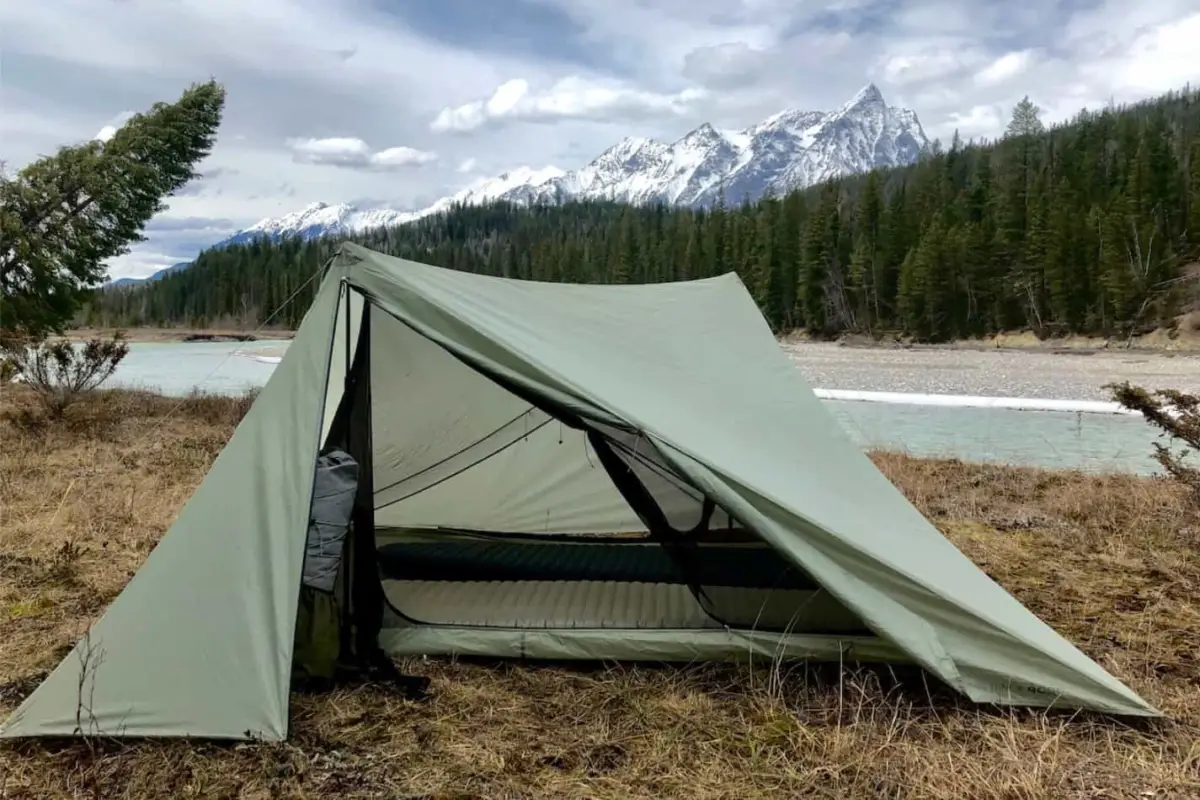When you are looking at a tent for a thru-hike, you need to have some additional criteria you may typically not put much weight on; one of these is that the tent has a vestibule.
What makes the extra storage space valuable to a thru-hiker, you may wonder. Let’s dig in, look deeper, and explain this gear in more detail.
Tent vestibule storage is helpful as it provides extra space to store gear outside the living area. When your shoes are caked with mud and gunk, you don’t always want to bring them inside, and a vestibule protects them from the elements.
Additionally, with some tents like the X-Mid, the vestibule area can be nearly as big as the tent itself, which allows for more storage but a feeling of more space even when the tent is fully zipped up for battling the weather, helping you feel less enclosed.
Vestibules: Your Trail Mudroom
Well, when you are new to thru-hiking and maybe backpacking, in general, you need to learn all this new terminology along with all this new information about the gear itself. What is a vestibule?
Think about a vestibule as a sort of mudroom or waterproof covering and a way to get changed from the muddy and wet gear before entering your clean and dry tent and sleep system. They also give you space to store gear away from the inside of a cramped tent.
Now that we have answered that question let’s move on and talk about your backpacking tent and the purpose of its vestibule, along with exploring why they are good for thru-hikers in general.
Why Vestibules Improve Trail Life
Since we now understand that the vestibule can help give you a place to get out of the dirty, grimy, and honestly quite stinky clothing and gear, what are vestibules functional for or provide?
The main purpose of a vestibule is to provide a protected area for your use, either in front or to the side of your tent body. This space is outside the tent walls but still under the fly, providing rain and weather protection, which can be ideal.
When you are out on the trail, having spaces that can keep gear dry and protected is at a premium. A vestibule or two provides much more space to spread out and cook, clean, and relax, which are all necessities on a long trail.
To Vestibule or Not for Thru-Hikes?
This may heavily depend on the thru-hiker. If you are going to avoid shelters in most cases and live in your tent for nearly 6 months, you will want every ounce of space for your home on the trail.
In many cases, a vestibule helps you to store gear outside and away from the internal tent body space giving you more space to stretch out and to go through post-hiking processes like rolling out muscles with a cork ball.
I use an X-Mid 1P and the space inside the mesh is truly limited, but the vestibule space is just amazingly large. I can easily fit all my gear inside with a load of space remaining to maximize the space and not feel claustrophobic!
On the other hand, if you hike into hiker midnight territory, or late, on most nights and are minimal to sleeping once the tent is up, then cutting weight and minimizing vestibule space could help you get further faster.
Vestibule Styles: What’s Best for You?
The most common tent vestibule types are categorized into front and side. Most vestibules are floorless and rely on the strength of your tent to keep them in place.
There are also little-known add-on options, frequently used in car camping as they tend to be heavier. You may still see people building makeshift versions due to the benefits of tent vestibules, so let’s discuss the types of tent vestibules below.
Front Vestibule
The front vestibules cover the tent’s entrance while providing space for gear. Vestibules are typically built into the tent body and are useful when bad weather is expected, such as during winter.
Vestibules outside a shelter can be huge, allowing you to store many gear out of the elements.
This is wonderful if your shelter’s inside is cramped or has hefty equipment that needs more rain protection.
They also function as an enclosed porch when it rains, so you may carefully prepare meals beneath them without getting wet.
Side Access Vestibule
My preferred type of vestibule space is side vestibules. These are typically on very wide side spaces that allow you to get in and out easily, as you can store your gear on one side and have the exit door on the other side.
I also prefer the side-based vestibules as on the front vestibule, you have to climb in or out over everything you leave in the spot as you typically will only have one front door, which heads right out to the gear you left in the way of your own doorway.
Add-On Vestibule
Some tents won’t come with vestibules or may come with super small and compact vestibule spaces. In this case, you could buy a specifically built add-on vestibule, but for thru-hiking, this would be a silly amount of weight to add.
If you add your DIY-ness, you could carry something that could act as a roof for a temp space, like a tarp or other waterproof fabric that could be set up similar to a tarp providing rain and element protection.
Cooking in Vestibules: Don’t Do It!
To be totally honest, cooking inside a vestibule or tent might be extremely hazardous or even fatal.
You could easily burn your tent or get carbon monoxide poisoning by poor airflow, and then it is also a clear invitation for animals to investigate your camp spot.
Typically cooking inside or around your tent is a bad idea. It invites the animals to check out the tent spot, which can be very dangerous to you or others.
You should always cook at least 100 feet from the camp spot to ensure no food smell permeates the area where you intend to sleep.
For areas where bears exist, this is dangerous for you, and for them, many of these bears will be put down if they become too friendly and encroach on people without fear and that isn’t fair to them.
Additionally, rodents like mice may decide to investigate smells and eat holes into your gear, from backpacks, clothing, and tents, and leave you with broken and inefficient gear until you can reach the next town.
Footprint Tips for Vestibule Coverage
If you don’t know what a tent footprint is, I have a very useful post covering what a footprint is over here.
Whether you should have a footprint area in your vestibule may depend more on how the tent lays out and if you bought a tent-specific footprint.
If you instead followed what I wrote and chose to make your own footprint to drop weight and customize your gear, then you could cut the footprint to cover any space you want as long as it is covered by the rain fly.
As an important note, you ALWAYS want your footprint not to be seen outside the rainfly as you don’t want it to capture water and bring it between your tent and the footprint, so I normally cut the footprint a few inches short of an edge.
Choosing the Right Vestibule Size
For most thru-hikers, you will have less gear to store, like a backpack, shoes, and camp shoes.
It’s not like you have a bike or other larger gear that needs to be protected.
This allows you to have less overall vestibule space for your tent than someone else who is choosing to bikepack. If you were to do this biking long-distance travel you would need a huge space to keep your bike dry.
Most will want enough space to comfortably fit their gear while they change clothes and a place where they can heat up water for something like coffee in the morning.
The Verdict: Are Vestibules Worth It for Thru-Hikes?
Choosing whether you need any vestibule, whether on just one side or on both sides of your tent will be a highly personal decision and none of them is the wrong way to go as each person camps differently.
Personally, I am a fan of dual vestibules as this allows me to store gear on either side and the other side could be used for entering and exiting the tent without having to shift around your bulky gear.


Leave a Comment